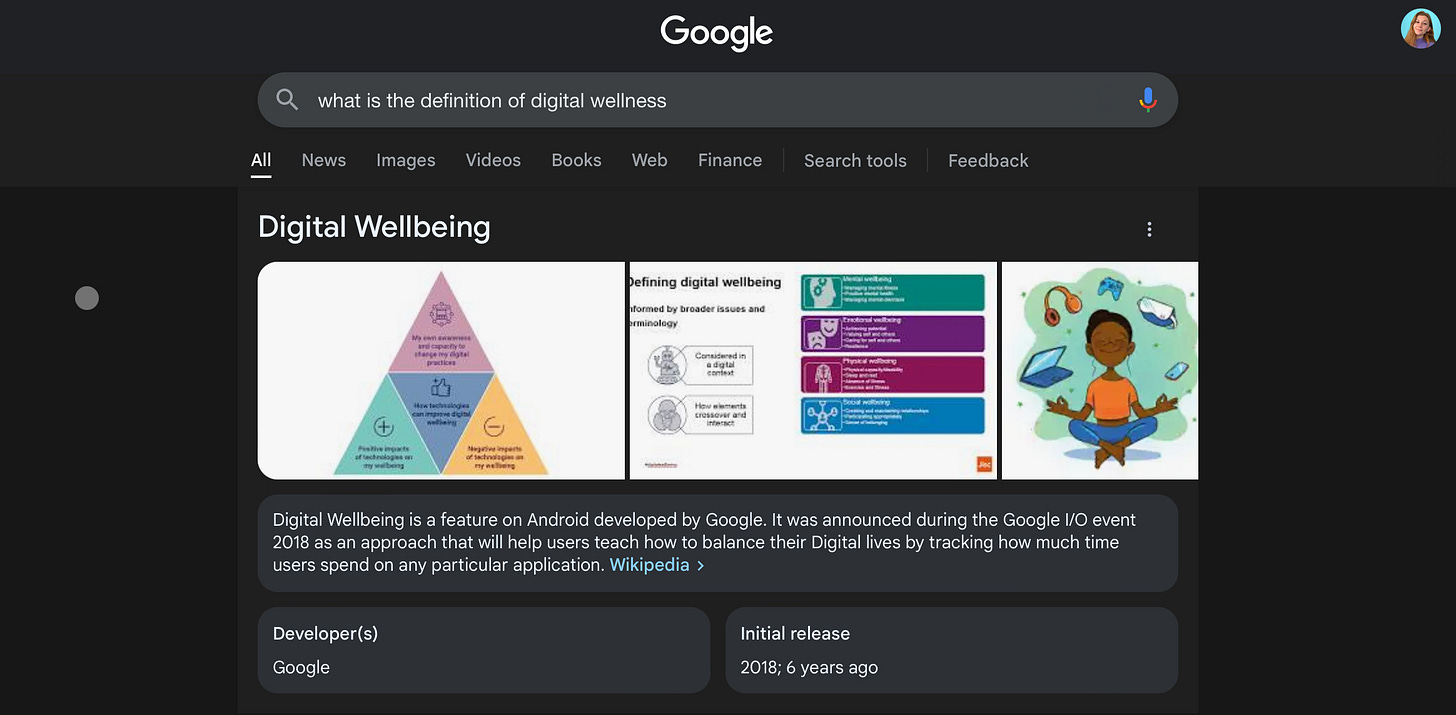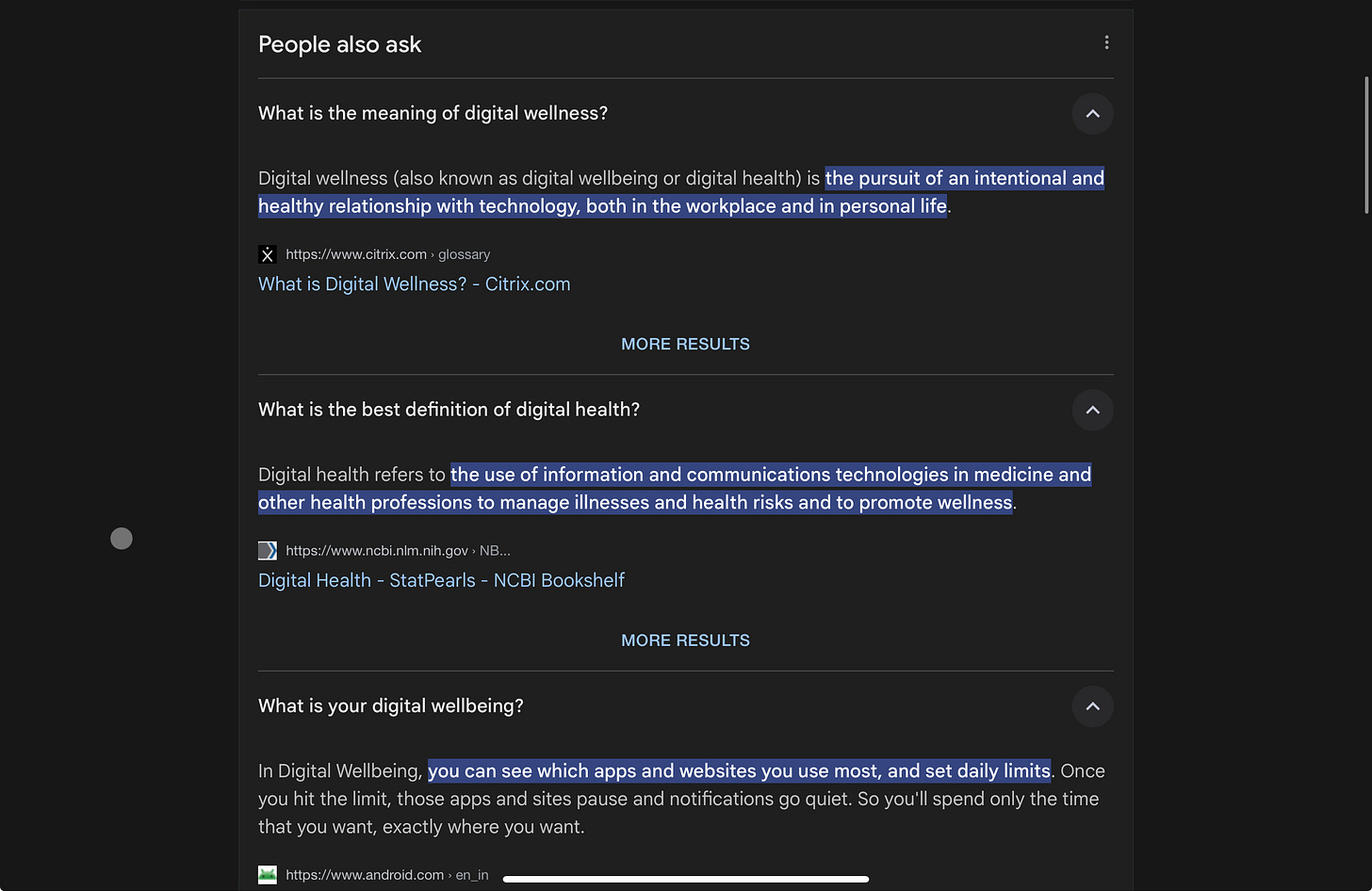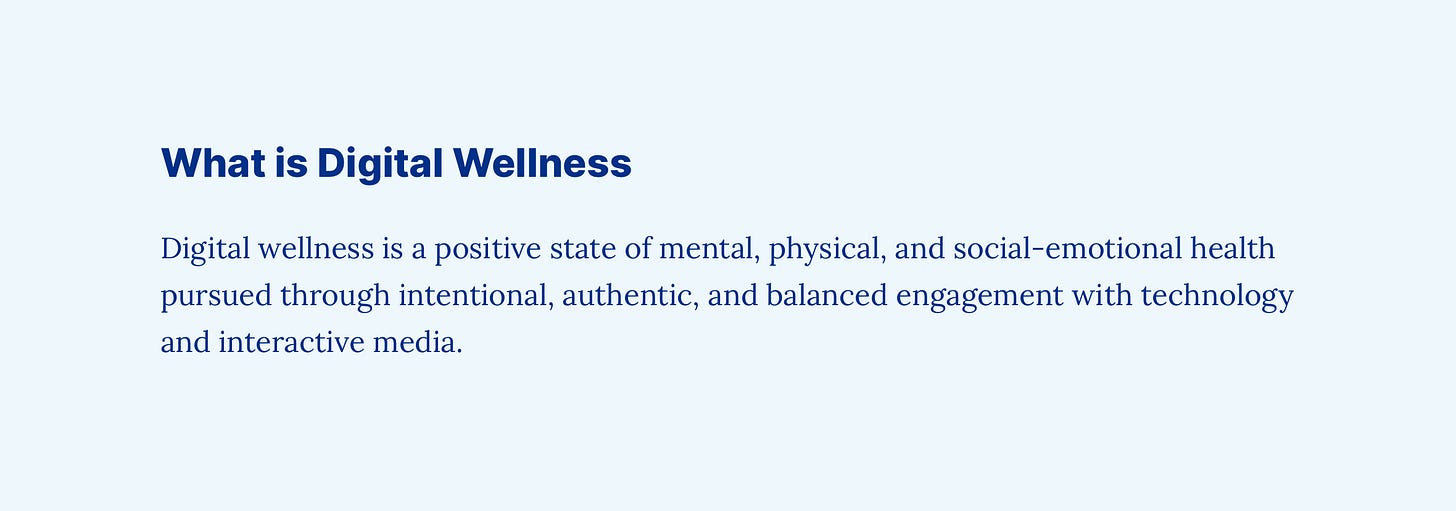Digitally Exhausted came to be because I wanted a place to share my thoughts on tech’s societal impact. My writing covers social media’s spaghetti-like complexities, the curiosities of BIG tech, and why digital self-care is just as important as eating your vegetables.Thanks for reading Digitally Exhausted! Subscribe for free to receive new posts and support my work.
Asking “What do you do?” flutters my anxiety.
I reply “I work part-time at a hotel and I’m growing my digital wellness business so I can help digitally exhausted social media professionals.”
Crickets… Crickets… And more crickets…
This is usually how these conversations go. But when someone replies, “What’s digital wellness?” I feel like I’ve won the lottery because I get to ask them, “What does digital wellness mean to you?”
My dear reader (or listener), what does digital wellness mean to you?
Digital wellness means getting back your human agency
Digital wellness (also known as digital wellbeing) has people stop and think because it’s (almost) a brand-spanking new idea, so I try not to take it personally when people stare at me like a deer in headlights.
A lot of people haven’t heard of digital wellness before, though they might have an idea of what it means because some apps have “digital wellbeing” features (e.g. measuring screen time or notifying you when it’s time to take a break). People might also know about digital wellness because organizations are adding it to their culture.
But what do these words mean?
Typing in Google search, “What is the definition of digital wellness” the answer box defines it as Android’s Digital Wellbeing feature:
This is not the idea of digital wellness. It’s a tool to help users balance their digital lives, an aspect of digital wellbeing, but we can dig deeper.
Scrolling past the answer box, there’s more clarity in the “People also ask” section.
Citrix shares it’s “the pursuit of an intentional and healthy relationship with technology, both in the workplace and in personal life.”
This is a great explanation, but the one I like to share with people is from The Digital Wellness Lab at Boston Children’s Hospital.
This definition paints a picture. It’s not simply stating “healthy” tech use and what’s healthy for you, might not be healthy for me or your friends and family.
What checks the box for these definitions is their choice of the word intentional.
How many times have you checked your phone “just because”? What about the times you’re working on a task but get distracted by notifications—sometimes, if not most of the time, they’re probably nonsense (i.e. meaningless to you at the moment) notifications?
Technology affects what we do and how we act. It influences our human agency, the feeling of control we get from our conscious actions and behaviors.
There are steps you can take to support your digital wellbeing but before I share a few things you can try, I want to make it clear that digital wellness is more than tech-life balance. It’s more than trying to reduce your screen time, do a digital detox, or go cold turkey with social media.
Yes, these are wonderful challenges with great rewards but you can still become a mindless zombie (i.e. get sucked into mindless tech use).
If you digested anything from this post, I hope it’s to practice intentionally using the technology you have in your life.
Now, my dear reader (or listener), what actions can you take to be more intentional with your tech use?
Ideas you can try to practice consciously using technology
Tech use is intimate. What we have on our phones and how we engage with them is personal. From the wallpapers we choose to the apps we have, devices are an extension of our person.
If you are working on intentionally using the technology you have, here are actions I take to be more conscious online:
Using Focus features on devices: This filters or silences notifications so I can focus on things like writing this post 😊 (available for iPhone and Android users, not sure about other devices)
Removing apps and email subscriptions I don’t use or read: This reduces so much distraction from nonsense notifications. Bonus, it tidies up my devices and email inbox.
Placing my phone out of sight, so it’s out of mind: Research indicates that even the mere presence of smartphones has negative effects on learning performance and attention. Working on my laptop, instead of placing my phone beside me I put it behind the screen so I can’t see it.
Utilizing grayscale: This makes my phone less enticing to pick up “just because”. Whenever I get into a short-form video scrolling phase, I put my phone in grayscale because I’ve found that I tend to stay on course with why I grabbed my phone in the first place versus mindlessly opening Instagram.
Let me know how it goes if you try one of these ideas. If you don’t know which one to start with, grayscale is a fun one to try.
Currently, digitally exhausted with…
Tech glitches that turn the world upside down (i.e. CrowStrike Outage). This goes to show how much we rely on technology and that we should probably have a crisis plan for when technology just doesn’t work.
📰 TechScape: Why CrowdStrike-style chaos is here to stay (an interesting article to learn more about what happened and why this might happen again).
Wherever you are, be there ✨
It’s that time of year in Galway, the sunshine is gracing us with her presence more so than not and the town is buzzing with tourists from all over the world.
Right now, the Galway International Arts Festival is happening which means the sunsets are even better thanks to the big top.
Can you spot the fisherman?
Until next time,
Wherever you are, be there.
Pssssssst… Enjoy this post? If so, you might fancy Who are you uninterrupted? and Algorithms shape personalities.
Learn about digital wellness coaching at imcelinemarie.com








I love the digital wellness definition from the Boston Children’s Hospital!
Recently, I’ve tried making “no phone” rules for spaces I want to cultivate as calm and sacred. Right now, it’s airplanes, the lunch table, and I’m trying to make it my bed as well. I replace my phone with journal writing, a book, and people watching in these spaces.